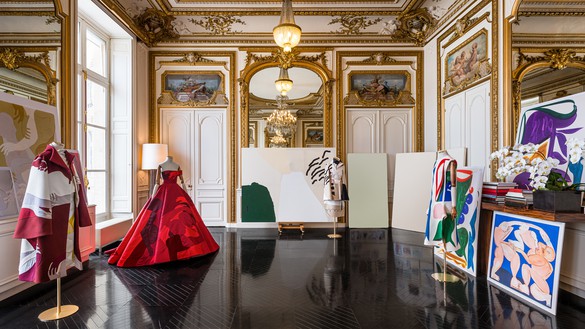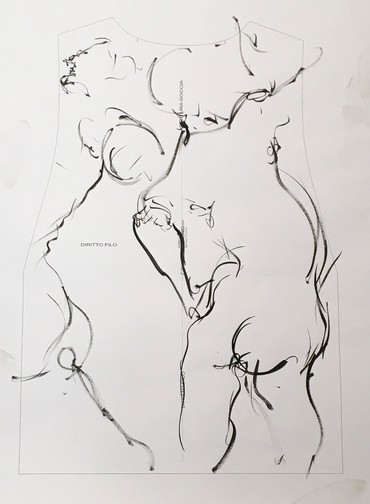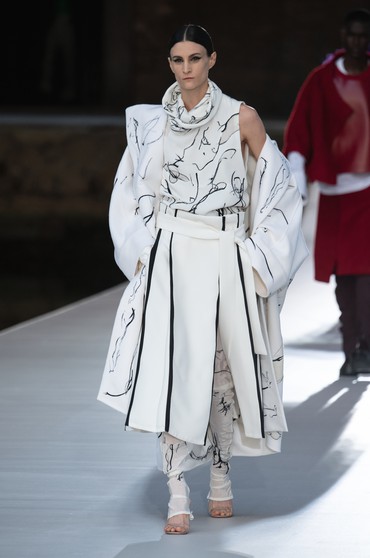Wyatt AllgeierI’m curious how this partnership between Valentino’s Haute Couture atelier and these artists began. Did Pierpaolo approach you?
Gianluigi RicuperatiI wrote an op-ed piece for Il Sole 24 Ore about the idea of fashion brands sustaining artists and culture. I was thinking about how a brand could function as a tool for societal renewal. It seems that I used some language that resonated with Pierpaolo’s thinking about Valentino, because after a few days I received a beautiful bouquet of flowers with some of the words that I used in the article transcribed by him. This initiated our conversation.
Pierpaolo told me about a dream of his to have a factory of sorts, a place where artists could collaborate and engage in dialogue with the haute couture atelier. So I went to Rome and we began looking into how this could function. I proposed a variety of artists—sixty or seventy, of various generations, various levels of prominence, working in different mediums. Interestingly, we became chiefly interested in working with painters, and the list narrowed down.
WAHow did you arrive at the final list of sixteen artists?
GRThe decision was made organically, each chosen by Pierpaolo based on a gut feeling. We did our research, and he knew their stories, their motifs, and their research, but basically it was instinct that guided the decision.
The second step was putting everything on a mood board. We started looking at particular works by each artist. Though it wasn’t about putting together an exhibition, it was about the creation of a haute couture collection; there was a curatorial necessity to make everything harmonious, in terms of chromatic cohesion and so on.
In the end, what we found by looking deeply at this mood board was that it worked; it created a synchronized landscape of colors and forms. And that’s the moment the project blossomed. From there, the one-on-one dialogue with each artist could begin. It was a conversation based in the art of translation, in many ways—a translation between a two-dimensional form, painting, and a three-dimensional, volumetric, more sculptural form, haute couture. This is very important, because Pierpaolo wanted to be clear that fashion and art are different; they are united by dialogue, but they are distinct entities.
WAWere the artists asked to create new works, or was the team at Valentino responding to preexisting works by these artists? What was that process like once the artists were selected?
GRThe process was basically about a back-and forth, a ping-pong. It began with a single artwork by each artist, some of which already existed; some had already entered collections and weren’t actually available to exhibit, but this didn’t matter since they only needed to serve as the catalyst for the conversation. That was the ping; the pong was the moment when the artist, after seeing what Atelier Valentino did in this work of translation, in creating the dress, responded, whether in the form of a drawing, or an idea, or a painting . . . Joel S. Allen, a Colorado-based sculptor, started a new series of sculptures inspired by the process. Benni Bosetto, an Italian artist, worked directly with the atelier to insert some of her work into the dress. Every collaboration was different—some took place purely as dialogue, some were practical, some were inspirational.
WAThat’s refreshing, as so often “collaborations” are simply about reproducing a painting on a t-shirt, right? But this sounds more integrated and passionate.
GRYes, and hopefully these conversations between the artists and the atelier will continue, even after the couture show. I hope we started something akin to a growth chamber, a place where you assist a microorganism or a seed to grow by providing a situation that favors growth. And I think we have, because it’s based on a peer-to-peer situation. I like to think it’s the fashion response to the spirit of Black Mountain College, in a way: a totally cross-disciplinary attitude, where everybody learns from each other.
WAThe collection was presented in Venice. Was the location part of the thinking from the start, given the city’s historic role in art?
GRDefinitely. In Pierpaolo’s vision, Venice was always there. He wanted a setting that didn’t need to be touched. And also, the Venice Biennale is the place of experimentation and art, so I think it was inevitable to show there.
Photos: courtesy Valentino















